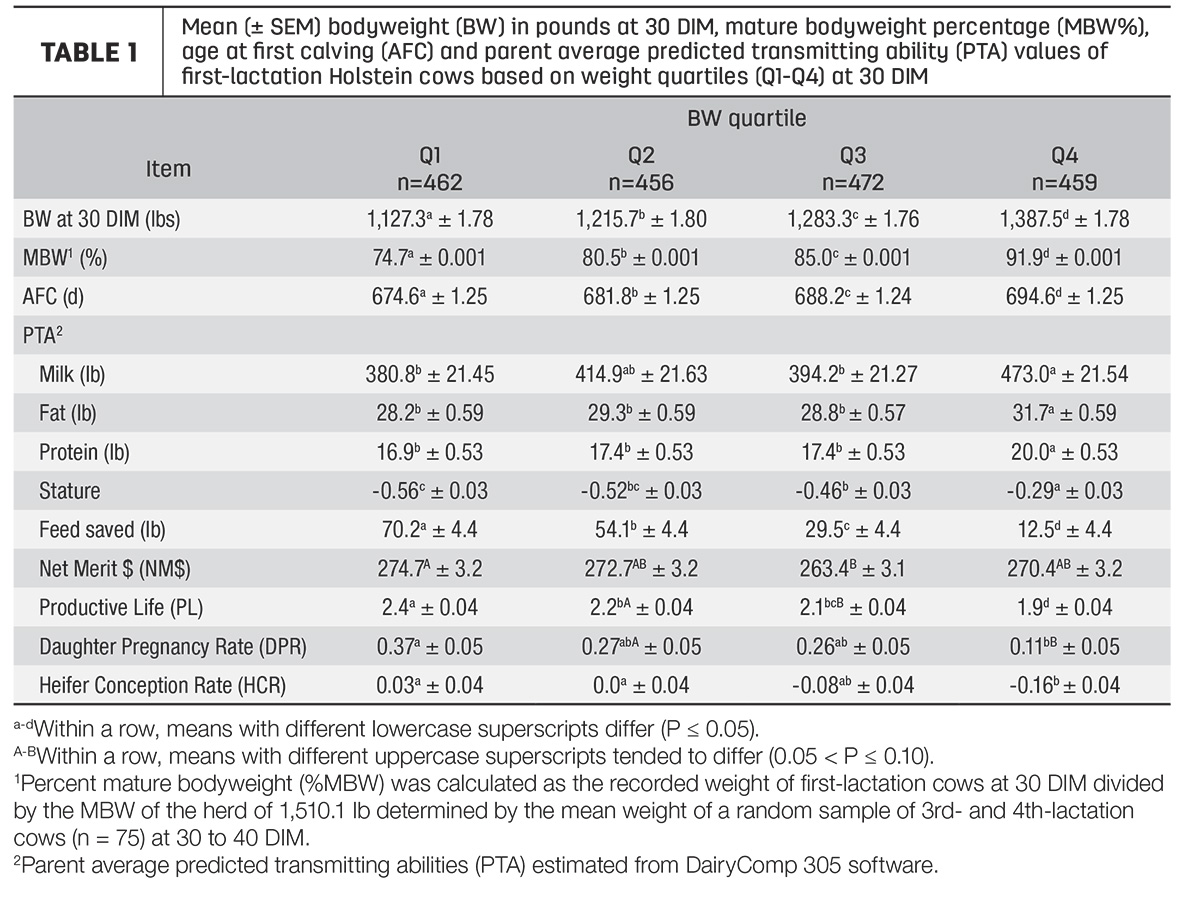Raising replacement heifers is one of the greatest costs incurred by dairy farms. With record-high input costs, there is greater pressure to decrease raising costs. The current trend in the dairy industry is to decrease age at conception, thereby decreasing age at first calving (AFC) to decrease raising costs by generating income from milk production sooner. While this may decrease raising costs, implementing this strategy without considering the growth benchmarks relative to mature body size of heifers to fulfill their genetic potential could be costly.
Mature body size is defined as the mature bodyweight and height of third-and-greater-lactation cows in a herd measured at a consistent days in milk (DIM). Heifers at first insemination should be 55% mature bodyweight and 85% mature bodyweight post-calving. Only 36% of U.S. dairy heifer growers record bodyweight and average daily gain (ADG) of heifers. For an earlier age at conception and age at first calving, it is essential to calculate a targeted growth rate relative to mature body size to ensure adequate growth and limit overconditioning to optimize future milk production. With few U.S. dairy farmers measuring heifer growth, adoption of an earlier age at conception and age at first calving was likely done without consideration for mature body size benchmarks and could be limiting first-lactation milk production.
Methods and management
Our objective was to determine the relationship between insemination eligibility and the reproductive performance of heifers on first-lactation bodyweight at 30 DIM and milk production during weeks four, eight and 12 of lactation. We analyzed a large data set from a commercial dairy herd in the Upper Midwest with heifers raised offsite at calf and heifer growers located in the Central Plains. Heifers were eligible for first insemination at 380 days old and were inseminated with sexed semen based on detection of estrus. The incidence of bovine respiratory disease (BRD) was recorded, and heifers were categorized as either healthy or having one or more BRD incidences before calving. From the commercial dairy herd management software, parent average predicted transmitting abilities (PTA) values were estimated for milk, fat, protein, stature, feed saved (FS), Net Merit Dollars (NM$), Productive Life (PL), daughter pregnancy rate (DPR) and heifer conception rate (HCR).
The mean mature bodyweight of the herd was 1,510 pounds and was estimated by weighing third- and fourth-lactation cows (n = 75) at 30 to 40 DIM. First-lactation Holstein cows were weighed at 30 DIM and the percent mature bodyweight (%MBW) was calculated for each cow as the first-lactation bodyweight at 30 DIM divided by the mean herd mature bodyweight. The mean weekly milk yield of first-lactation cows at weeks four, eight and 12 of lactation was calculated as the mean of the mean daily milk yields for each week. The final data set included 1,849 first-lactation Holstein cows that were ranked into quartiles (Q) based on bodyweight at 30 DIM and %MBW in ascending order as follows: Q1 (lightest; n = 462), Q2 (light-moderate; n = 456), Q3 (moderate; n = 472) and Q4 (heaviest; n = 459).
Quartiles
The demographics of quartiles including bodyweight at 30 DIM, %MBW, AFC and PTA values are presented in Table 1.
 By design, the mean bodyweight and %MBW of cows increased linearly by
quartile with only Q3 and Q4 cows reaching the industry benchmark of 85%
mature bodyweight post-calving. Also, the mean age at first calving
increased linearly by quartiles with Q4 cows calving approximately 20
days later than Q1 cows. On average, Q4 cows had a greater genetic
potential for milk production than Q1 and Q3 cows, but not Q2. Further,
the genetic potential for stature and feed efficiency differed among
quartiles, with Q4 cows having greater genetic potential for height and
being less feed efficient than Q1, Q2 and Q3 cows. Interestingly, the
PTA values for DPR and HCR differed among quartiles, with Q1 cows having
more genetic potential for DPR and HCR than Q4 cows.
By design, the mean bodyweight and %MBW of cows increased linearly by
quartile with only Q3 and Q4 cows reaching the industry benchmark of 85%
mature bodyweight post-calving. Also, the mean age at first calving
increased linearly by quartiles with Q4 cows calving approximately 20
days later than Q1 cows. On average, Q4 cows had a greater genetic
potential for milk production than Q1 and Q3 cows, but not Q2. Further,
the genetic potential for stature and feed efficiency differed among
quartiles, with Q4 cows having greater genetic potential for height and
being less feed efficient than Q1, Q2 and Q3 cows. Interestingly, the
PTA values for DPR and HCR differed among quartiles, with Q1 cows having
more genetic potential for DPR and HCR than Q4 cows.
BRD incidence and reproductive performance as heifers
Before first calving, 27.4% of heifers had one or more BRD incidence, and there was an association between bodyweight quartile and the proportion of heifers with one or more BRD incidence. The BRD incidence of Q1 cows as heifers was 9 to 11 percentage points more than Q2, Q3, and Q4 cows (Figure 1A). As first-lactation cows, cows healthy as heifers were heavier at 30 DIM than cows with one or more BRD incidence as a heifer (1,258.6 pounds versus 1,240.1 pounds). The incidence of BRD as a heifer was not associated with pregnancies per A.I. at first insemination as a heifer.
 However, bodyweight quartile was associated with pregnancies per A.I. at first service as heifers, with Q1 cows having approximately 9 to 26 percentage points more pregnancies per A.I. at first insemination as heifers than Q2, Q3 and Q4 cows (Figure 1B). Since Q1 cows conceived and calved approximately 20 days earlier than Q4 cows, Q1 cows had fewer days on feed, thereby a shorter growth period as heifers before first calving to achieve 85% mature bodyweight. By contrast, at first insemination as heifers, over half of Q4 cows failed to conceive, allowing for one or more estrous cycles to grow before conceiving at a later insemination. The separation of heifers into the bodyweight quartiles in this analysis is mainly due to differences in genetic merit for fertility traits and subsequent reproductive performance because heifers were solely eligible for first insemination based on age.
However, bodyweight quartile was associated with pregnancies per A.I. at first service as heifers, with Q1 cows having approximately 9 to 26 percentage points more pregnancies per A.I. at first insemination as heifers than Q2, Q3 and Q4 cows (Figure 1B). Since Q1 cows conceived and calved approximately 20 days earlier than Q4 cows, Q1 cows had fewer days on feed, thereby a shorter growth period as heifers before first calving to achieve 85% mature bodyweight. By contrast, at first insemination as heifers, over half of Q4 cows failed to conceive, allowing for one or more estrous cycles to grow before conceiving at a later insemination. The separation of heifers into the bodyweight quartiles in this analysis is mainly due to differences in genetic merit for fertility traits and subsequent reproductive performance because heifers were solely eligible for first insemination based on age.
Milk production
There was no association between BRD incidence and milk production at weeks four, eight or 12 of lactation. The association between BRD incidence and first-lactation milk production could be underestimated because heifers with the most severe BRD incidences were more likely to be culled. Further, the incidence of BRD as a heifer likely affects milk production indirectly through decreased growth during the raising period. We found a positive association between bodyweight quartile and first-lactation milk production during weeks four, eight and 12 of lactation (Figure 2). On average, Q4 cows produced approximately 10 pounds per cow per day more milk than Q1 cows (Figure 2). With a shorter growth period to achieve 85% mature bodyweight, Q1 cows were unable to realize their genetic potential for milk production because energy was likely redirected to growth rather than lactation.

Definitions matter
Insemination eligibility and reproductive performance of heifers were associated with first-lactation bodyweight at 30 DIM and milk production during weeks four, eight and 12 of lactation. The lightest cows were associated with the greatest genetic potential for fertility traits and had approximately 26 percentage points more pregnancies per A.I. as heifers than the heaviest cows. By having the most pregnancies per A.I. at first insemination as heifers, the lightest cows had fewer days on feed, thereby a shorter growth period as heifers to achieve the industry benchmark of 85% mature bodyweight. The consequence of this shortened growth period was approximately 10 pounds per cow per day less milk production compared with the heaviest cows. Heifer body size relative to mature body size must be considered with age when implementing an aggressive reproductive management program to ensure a heifer realizes her genetic potential. Paired together, there can be fewer days on feed to shorten the raising period without sacrificing future milk production.
To read the full article, visit JDS Communications.






